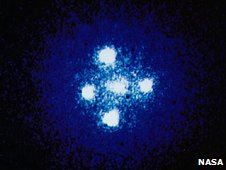090615
Hint of planet outside our galaxy
Astronomers believe they have seen hints of the first planet to be spotted outside of our galaxy.
Situated in the Andromeda galaxy, the planet appears to be about six times the mass of Jupiter.
The method hinges on gravitational lensing, whereby a nearer object can bend the light of a distant star when the two align with an observer.
The results will be published in Monthly Notices of the Royal Astronomical Society (MNRAS).
The team, made up of researchers from the National Institute of Nuclear Physics (INFN) in Italy and collaborators in Switzerland, Spain, and Russia, exploited a type of gravitational lensing called microlensing.
The effect of large, massive objects between an observer and a distant planet or star can cause distortion or multiple images as the intermediary object's gravity bends the passing light. Microlensing, by contrast, occurs when a less massive object lies in the middle. “ The technology is in place to truly see planets of Jupiter's mass and even less in other galaxies ” --- Francesco De Paolis INFN
There is a noticeable increase in the observed intensity of light coming from the aligned pair as the intermediate object focuses the distant one's light.
Because the effect depends on smaller objects that will be moving quickly relative to one another, microlensing events are fleeting, happening over the course of minutes or hours. Moreover, the mutual alignment of two small, far-flung objects with an observer on the Earth is exceptionally rare.

For that reason, dense collections of millions of stars, such as the Andromeda galaxy, are surveyed in order to detect them.
'Exceptional'
Francesco De Paolis of the INFN and his colleagues developed a computer model to determine the likelihood of detecting an exoplanet via a microlensing event in the Andromeda galaxy.
They modelled the "light curve", the variation in light that a microlensed star would exhibit if it were being orbited by a companion - another star or a planet.
Having determined the clues that a planet in Andromeda would show, they returned to a survey completed in 2004 by the Point-Agape collaboration of astronomers that showed an unusual light curve.
That event, the group says, matches up to its theory and can be attributed to a companion of a mass about six times that of Jupiter.
That suggests either a planet, or a small companion star such as a brown dwarf.
Unfortunately, given that microlensing events from a given pair of objects happens just once, astronomers cannot return to the planet candidate to confirm the idea.
But Dr De Paolis is encouraged by the possibility of detecting planets at such phenomenal distances.
"The interesting thing is that the technology is in place to truly see planets of Jupiter's mass and even less in other galaxies," he told BBC News. "It's an exceptional thing."
Armed with the new theory, the authors of the work are looking to secure time on a larger telescope to continue with their observations in the hope of finding more candidates.
With about 350 extra-solar planets already found in our galactic neighbourhood, Dr De Paolis said, it was likely that such candidates were abundant. The difficulty is in catching sight of one through a gravitational lens.
"It's not easy, obviously," he said. "The problem is that we don't know when a gravitational microlensing event is going to happen."
61.5m 거대날개 ‘바람을 내품에’
‘날개의 제왕(Blade King)’. 덴마크 리소연구소 연구원들이 엘엠글래스화이버(LM Glasfiber)에 붙인 애칭이다.
이 회사는 세계 풍력발전 회전날개 시장의 25%를 점유한 독보적인 기업이다. 베스타스, 지멘스 등 세계 10대 터빈제조업체 가운데 8개사가 이 회사에서 날개를 공급받는다. 지난해 수익은 8억8500만유로(약 1조5600억원)로, 인근 유럽국가 뿐 아니라 미국·중국·인도에도 현지공장을 가동해야 할 정도로 주문량이 밀려오고 있다.

지난 9일 찾은 루너스코우의 글래스화이버 덴마크 공장도 독일 해상풍력발전단지에 쓰일 세계 최대 크기의 61.5m 날개 제작을 마무리하느라 여념이 없었다. 헬레 라슨 아너슨 홍보팀장은 “아직까지 다른 어떤 회사도 날개 크기와 개발 노하우에서 우리 회사에 맞설 수 없다”고 자신감을 표시했다. 61.5m 길이의 회전날개(사진 위)는 17톤 무게로 날개 셋을 터빈에 조립할 경우 회전반경은 무려 126.3m에 이른다. 지구상에서 가장 큰 구조물인 셈이다. 이 풍력발전 1기에서 생산할 수 있는 전기는 6㎿로 6천가구에 공급할 수 있는 용량이다.
회전날개는 풍력터빈의 모터 역할을 하는 핵심부품으로 발전용량과 효율성을 좌우한다. 또 풍력발전 전체 비용의 20% 가량을 차지한다. 조만간 이 회사는 125m 크기 날개에 도전할 계획이다. 현재 30여 종류의 날개를 생산하고 있지만 매년 4~6개의 새로운 날개를 개발하고 있다. 이를 위해 수익의 3~4%가 투자된다. 세계에서 단 하나뿐인 풍력 실험실(윈드터널)에선 각종 악조건에서 20년 이상 견뎌낼 수 있는지를 꼼꼼히 검증한다.
이런 연구개발 덕에 지난 20여년동안 제작비는 절반으로 줄이면서도 성능은 20배나 높였다. 아너슨 팀장은 “바람이 보다 오래 머물도록 하는 게 날개 설계의 핵심”이라며 “풍력발전 대형화 추세에 맞춰 날개를 보다 가볍고 오래 가도록 하기 위해 식물재료를 활용하는 연구를 진행 중”이라고 말했다.